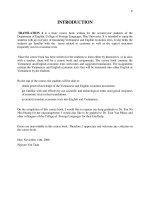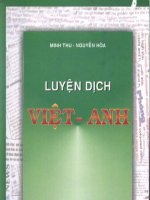H45 1 r luyện dịch 1
Bạn đang xem bản rút gọn của tài liệu. Xem và tải ngay bản đầy đủ của tài liệu tại đây (555.71 KB, 8 trang )
TRƯỜNG ĐẠI HỌC MỞ THÀNH PHỐ HỒ CHÍ MINH
KHOA NGOẠI NGỮ
LƯU HÀNH NỘI BỘ
1
MỤC ĐÍCH
Tài liệu này nhằm hỗ trợ cho học viên hình thức giáo dục từ
xa nắm vững nội dung ôn tập và làm bài kiểm tra hết môn
hiệu quả.
Tài liệu này cần được sử dụng cùng với tài liệu học tập của
môn học và bài giảng của giảng viên ôn tập tập trung theo
chương trình đào tạo.
NỘI DUNG HƯỚNG DẪN
Nội dung tài liệu này bao gồm các nội dung sau:
Phần 1: Các nội dung trọng tâm của môn học. Bao gồm các nội
dung trọng tâm của môn học được xác định dựa trên mục tiêu
học tập, nghĩa là các kiến thức hoặc kỹ năng cốt lõi mà người
học cần có được khi hoàn thành môn học. Mô tả cách thức để
hệ thống hóa kiến thức và luyện tập kỹ năng để đạt được
những nội dung trọng tâm.
Phần 2: Hướng dẫn làm bài kiểm tra. Mô tả hình thức kiểm
tra và đề thi, hướng dẫn cách làm bài và trình bày bài làm và
lưu ý về những sai sót thường gặp, hoặc những nỗ lực có thể
được đánh giá cao trong bài làm.
Phần 3: Đề thi mẫu. Cung cấp một đề thi mẫu, có tính chất
minh họa nhằm giúp học viên hình dung yêu cầu kiểm tra và
cách thức làm bài thi.
PHỤ TRÁCH KHOA NGOẠI NGỮ
Nguyễn Thúy Nga
2
Phần 1
CÁC NỘI DUNG TRỌNG TÂM
-
Sinh viên luyện dịch các văn bản bằng tiếng Anh về các đề tài
Giáo Dục, Kỹ thuật công nghệ , và các văn bản Văn học.
- VOA Learning English
- Education and Technology reports
- Một số chuyện ngắn Văn học
- Các bài đọc ý nghĩa trích trong sách “Chicken soup for the
soul”
- Sinh viên cần luyện Luyện phát âm chuẩn theo các file video
clips kèm theo bài học.
3
Phần 2
HƯỚNG DẪN LÀM BÀI KIỂM TRA
Sinh viên cần lưu ý những điểm sau:
Chỉ được sử dụng từ điển giấy trong quá trình làm bài
Không được mang bất kỳ tài liệu nào khác vào phòng thi
ngoài từ điển giấy
Sắp xếp thời gian làm phần dịch Anh-Việt.
Lưu ý cách diễn đạt ngôn từ, các phép liên kết trong văn bản
khi dịch Anh – Việt.
HÌNH THỨC KIỂM TRA
Đề thi thiết kế theo hình thức tự luận. Thời gian làm bài 90 phút.
- Phần 1: Dịch Anh – Việt (5 điểm) bao gồm một văn bản
thuộc thể loại Giáo dục
- Phần 2: Dịch Anh – Việt (5 điểm) một thuộc thể loại Kỹ
thuật Công nghệ hoặc một trích đoạn về tác phẩm Văn học.
HƯỚNG DẪN LÀM BÀI
- Sinh viên làm bài trên giấy thi và ghi rõ phần dịch Anh –
Việt. Lưu ý không ghi lại đề bài trên giấy thi.
- Sinh viên chỉ được sử dụng viết mực màu xanh, tím hoặc
đen trong bài làm của mình.
4
- Sinh viên được phát giấy nháp và sử dụng từ điển giấy của
mình trong quá trình làm bài.
- Tuyệt đối không được trao đổi hay chuyền giấy nháp trong
quá trình làm bài.
- Trước khi hết giờ làm bài, sinh viên nên dành ra 10 phút để
kiểm tra lại toàn bộ bài dịch.
5
Phần 3
ĐỀ THI MẪU
ĐỀ THI CUỐI KỲ LUYỆN DỊCH 1
(ĐỀ CHÍNH THỨC)
Môn thi:
LUYỆN DỊCH 1
Học kỳ: I/2014-2015
Thời gian:
90 phút
Ngày thi:
- Đề thi gồm 2 phần: phần 1 dịch Việt-Anh và phần 2 dịch Anh-Việt.
- Sinh viên chỉ được phép sử dụng từ điển giấy.
- Giám thị coi thi không giải thích gì thêm.
Part 1: Translate the following sentences into Vietnamese (5 điểm)
Academic Writing: Beyond the Five-Paragraph Essay
Millions of students have been taught a formula that has nothing
to do with chemistry or mathematics. The formula is for how to
write a five-paragraph essay. First, write an introductory
paragraph to state the argument. Then, add three paragraphs of
evidence. Finally, write a conclusion.
Linda Bergmann is director of the Writing Lab at Purdue
University in Indiana. Her job is to help students, including
international students, improve their writing. Professor
Bergmann has worked with many students who learned this
traditional five-paragraph formula. She says international
students sometimes have difficulty with this formula if they
6
learned a different writing structure. But just knowing how to
write a five-paragraph essay is not going to be enough for a
college student who has to write a longer academic paper.
As Professor Bergmann points out, the formula is too simple to
deal with subjects that require deeper thought and investigation.
In her words, "Essentially, it is way too simplistic to handle more
intellectually sophisticated topics which involve actual inquiry."
Karen Gocsik is executive director of courses in the Institute for
Writing and Rhetoric at Dartmouth College in New Hampshire.
The institute has an extensive library of online writing materials
on its website.
So what are the qualities that make up good writing? Ms. Gocsik
says there are no simple answers -- except maybe for one. That
is, there is no formula that students can follow to guarantee a
well-written paper. She says, "What we try to teach students to
do in college is to listen to their ideas, and that the idea should
be able to tell you what form it needs to take." She says moving
from secondary-school writing to college-level writing can be
difficult, but students should not be afraid. American college
students are usually expected to state their thesis at the
beginning of a paper.
In some cultures, students organize their paragraphs to build
toward the main idea at the end. And, while students in some
cultures use lots of descriptive words, American professors
generally want shorter sentences.
For VOA Special English, I'm Alex Villarreal. Tell us about your
own
experience
with
academic
writing.
Go
to
voaspecialenglish.com and share your stories. And before you
write that next paper, check out two links on our website. One is
7
for the Online Writing Lab at Purdue. The other is for the
Institute for Writing and Rhetoric at Dartmouth.
Part 2: Translate the following passage into Vietnamese. (5 điểm)
Some people get motion sickness from being in moving vehicles
such as cars or airplanes. But, a new device could stop motion
sickness by suppressing some signals in the brain. Motion
sickness happens when the motion you sense with your inner ear
is different from the motion you see.
Symptoms of motion sickness are dizziness, nausea and
vomiting. People have tried different ways to prevent the
condition, including wrist bands and anti-nausea drugs. But
often, nothing works. Now, scientists at Imperial College
London are working on a device to counteract motion sickness.
Michael Gresty is an expert on the condition. He says riding in a
car or a ship can make it difficult for some people to know what
is upright and how to best deal with it. The device sends a weak
electrical current through electrodes placed on a person’s head.
The electric current appears to cause the brain to suppress signals
that affect the inner ear. Researcher Qadeer Arshad says the
scientists found “that it took longer for the individual to develop
motion sickness and that they also recovered faster."
The next step is to test the device outside the laboratory. Michael
Gresty says there are no reports of unwanted side effects from
the small amounts of electricity released by the device. The
researchers hope a device that plugs into a smart phone and
attaches to the head will be available within 10 years.
THIS IS THE END OF THE TEST.
8









